Technical Notes - e1
![]() PubMed: Truncation, Automatic Explosion, Mapping, and MeSH Headings - e2
PubMed: Truncation, Automatic Explosion, Mapping, and MeSH Headings - e2
MLA 1998 [corrected 1998/07/14] - e3
BIOETHICSLINE Regenerated - e4
PubMed: Truncation, Automatic Explosion, Mapping, and MeSH Headings
In PubMed you retain many of the same search capabilities you enjoyed in ELHILL plus there are some new features. In both PubMed and ELHILL, if you search for a MeSH term without a subheading you will automatically retrieve that MeSH (MH) term with or without a subheading attached whether or not the MH is the main point of the article. However, in PubMed every MeSH term is also automatically exploded as well as any subheading that is the top of a "subheading tree."
This article discusses two of PubMed's indexes, the All Fields index and the MeSH Terms index, and how the search rules used to create these indexes affect your retrieval. MeSH terms are treated differently in these two indexes. In the All Fields index, the entry terms (see references) are not included and MeSH terms are not exploded. The All Fields index posts the retrieval for the specific MH, including all subheadings, whether or not the MH is the main point of the article. In the MeSH Terms index, the entry terms are not included but the MeSH terms are exploded.
PubMed in Brief
If you would like to read a bulleted summary of the main points in this article
please click on the heading above. For the complete explanation of why
and how these bulleted features work, please review the full text and the
figures that follow below.
PubMed Uses Translation Tables
When you enter your search terms without qualification or truncation, PubMed will go through its
translation tables looking for your terms. (Consult the online Help under Automatic Term Mapping for an explanation of these tables.) In the Advanced Search screen, when you see Search
Field: All Fields and Mode: Automatic, if you don't qualify or truncate your term, PubMed will
look in all its translation tables and search in the appropriate index (not just the All Fields index)
for your term.
PubMed Bypasses Its Translation Tables
Some operations restrict PubMed's searching to just one index and to the search limits that apply in creating that index. If you change the Mode: from Automatic to List Terms on the Advanced Screen, you will restrict your search to the index selected under the Search Field pull-down menu, bypassing the translation tables. Truncation on an unqualified term takes you directly to the All Fields index, without going through the translation tables. PubMed uses the first 150 variations of a truncated term. (See Truncation in PubMed's Help for more information.) Truncation on a term that you qualify with [MH] takes you directly to the MeSH Terms index, also without going through the translation tables.
The PubMed MeSH Terms index displays the MeSH/subheading combinations in the same way as the NEIGHBOR DETAILED (NBRDET) command in ELHILL. In both systems, if you select the MeSH heading at the top of the display, you retrieve citations indexed with both the plain MeSH heading and all the MeSH/subheading combinations. Again, remember the automatic explosion enhancement of PubMed in the MeSH Terms index.
The automatic mapping and Explode features will not operate under the conditions listed below.
Truncation Turns Off PubMed's Automatic See Reference Mapping Feature
If you run a search using truncation on a See Reference, e.g., breast cance*, you will not retrieve
the MeSH term Breast Neoplasms because truncation turns off mapping on both unqualified or qualified terms. Searching for breast
cance* retrieves only the phrases breast cancer and breast cancers.
Truncation of Unqualified Terms Turns Off PubMed's Automatic Explode Feature
If you run a search using truncation on an unqualified root MeSH term, for example breast
neoplasm*, you will automatically retrieve all citations with the index term Breast Neoplasms
whether or not a subheading is attached to this MeSH term. However, truncation of an unqualified term turns off
PubMed's automatic explosion feature, so searching on breast neoplasm* will not retrieve
citations indexed with the indented term, Mammary Neoplasms. Conversely, truncating a qualified root MeSH Term will retrieve exploded terms. While it is true that truncation in
PubMed does not cross a space boundary (searching breast* will not retrieve breast neoplasms),
the indexes are constructed to include MeSH/subheading combinations.
Using the List Terms Display in the Advanced Search Screen
Caution must be exercised when you are selecting a term from the List Terms display in the Advanced Search screen. Your results will vary greatly, depending on whether you are searching a See Reference or a MeSH heading, and also according to which index (All Fields or MeSH) you are searching. Selecting your term from the All Fields List Terms Display will turn off mapping and the automatic explosion feature as shown in the examples below; selecting your term from the MeSH Terms List Terms Display will keep the automatic explosion.
Selecting a See Reference to a MeSH Term from the List Terms Display with All Fields
Selected Turns Off PubMed's Mapping and Automatic Explode Features
If you click on Advanced Search and then select All Fields in the search field box and List Terms
in the Mode box (Figure 1) and type in breast cancer, a See Reference
to Breast Neoplasms, and click on Search, PubMed will display the postings (Figure 2) for the phrase breast cancer (42762) and breast cancers (3345). Please note that these two terms will be separated by many other breast cancer terms because breast cancer followed by a space displays
before breast cancerx (where x represents any letter attached to the word cancer). [Editor's Note:
All retrieval numbers represent searches done in early June.] If you select both breast cancer and
breast cancers from the List Terms Display, PubMed will retrieve 43,861 citations which is the
same number of citations retrieved with the search breast cance*. Remember, that if you had just
typed in breast cancer unqualified into any PubMed search screen and searched you would
retrieve 90,289 citations because MeSH mapping would allow you to retrieve Breast Neoplasms
Exploded and the phrase "breast cancer".
Figure 1 - Searching All Fields and List Terms for a See Reference to a MeSH Term
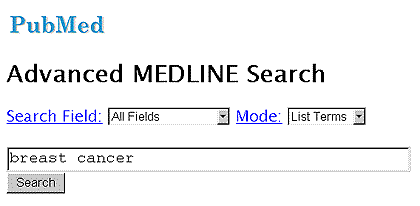
Figure 2 - Partial Display of Breast Cancer Terms in the All Fields Index
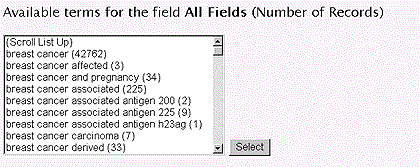
Selecting a MeSH Term from the List Terms Display with All Fields Selected Turns Off
PubMed's Automatic Explode Feature
If you display breast neoplasms in All Fields List Terms(Figure 3) you see the postings ( Figure 4) for the unexploded MeSH term breast neoplasms (75403) followed by the unexploded MeSH
term/subheading combinations all of which are incorporated into the 75,403 postings.
Figure 3 - Searching a MeSH Term in All Fields with List Terms
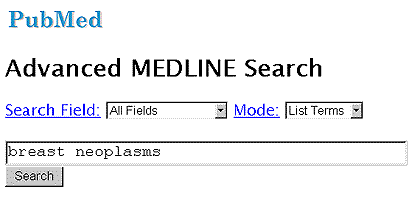
Figure 4 - Partial Display of Unexploded MeSH Terms in the All Fields Index
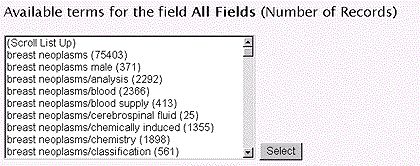
Selecting your Term from the List Terms Display with MeSH Terms Selected Keeps
PubMed's Automatic Explode Feature
If you display breast neoplasms for the MeSH Terms field in List Terms mode (Figure 5), you see
(Figure 6) 85914 citations for the exploded MeSH term followed by breast neoplasms/analysis
(5410) , breast neoplasms/blood (2575), etc. The postings for the MeSH/subheading
combinations are already included in the 85,914 as are the postings for any indentions (i.e.,
Mammary Neoplasms) with their subheadings.
Figure 5 - Searching MeSH Terms and List Terms for a MeSH Heading
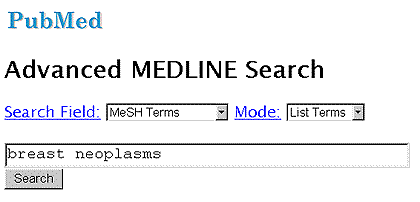
Figure 6 - Partial Display of Breast Neoplasms in MeSH Terms Index
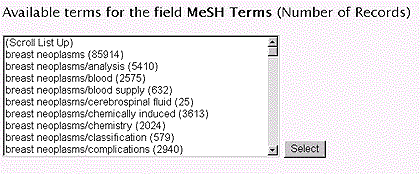
See References Do Not Display in PubMed's MeSH Index
If you click on Advanced Search and then select MeSH Terms in the Search Field, List Terms in
the Mode box, type in breast cancer, and click on Search (Figure 7), you will not see the phrase
breast cancer because it is a See Reference to a MeSH term and See References do not display in
the PubMed MeSH Terms index.
Figure 7 - Searching MeSH Terms and List Terms for a See Reference to a MeSH Term
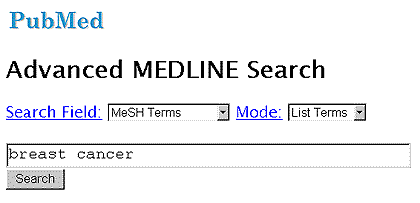
Figure 8 - MeSH Terms Index does not Display Breast Cancer
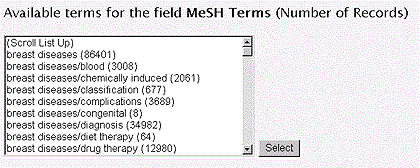
PubMed in Brief
- The All Fields index does not include MeSH entry terms and the MeSH terms are NOT exploded; every MeSH term listed includes all postings (main point of article or not, attached subheading or not).
- The MeSH Terms index does not include MeSH entry terms, but the MeSH terms ARE exploded; every MeSH term listed includes all postings (main point of article or not, attached subheading or not).
- MeSH Entry terms work through one of several Translation Tables that PubMed invokes for all unqualified (and also MH qualified) search terms.
- Truncation of unqualified terms bypasses all Translation Tables and directly looks in the All Fields index for a match; therefore, truncation "turns off" automatic MeSH mapping and explosions.
- Truncation incorporates the first 150 variations of the root term in the search and gives a warning message. For comprehensive results the search may need to be redone using a longer root term(s).
- Use the List Terms Mode with caution remembering the differences in the way the All Fields and MeSH Terms indexes are built and realizing that the entry terms do not post in the indexes.
Conclusion
Searching without qualification and/or truncation allows the powerful PubMed search engine to
map and do automatic explosions in addition to searching for the exact terms you have entered. If
you choose to truncate, qualify, or select your terms from the List Terms display, you may be
turning off these features and retrieving less than you otherwise would. You may wish to check your results against an unqualified search to see how your search
strategy has affected your retrieval. Use the Details button to view the translated search strategy.
- --prepared by Lou Knecht
- Deputy Chief, Bibliographic Services Division
- Kathi Canese and Toby Port
- MEDLARS Management Section
